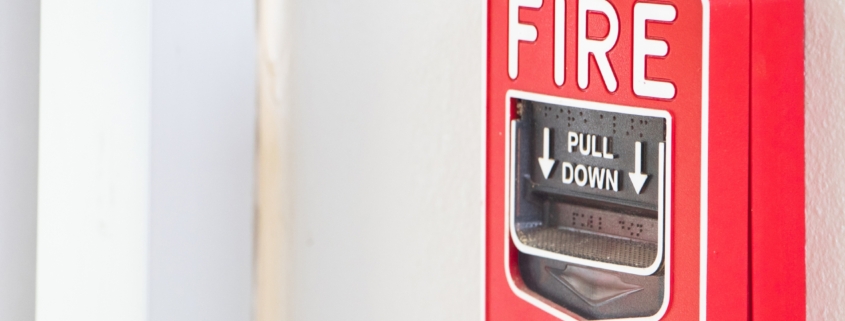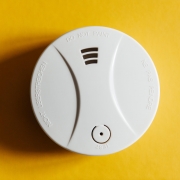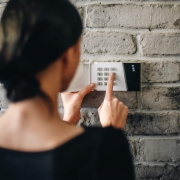How Fire Detection Systems and Alarms Work
Combination smoke detectors and fire alarm systems are lifesaving in buildings of all types. Fire is an extremely dangerous event and can easily get out of control. In addition to heat, smoke, and flames, fires can create a dangerous environment in which exposure to carbon monoxide, combustion particles, and other toxic substances can put lives in danger.
The Facts
The National Fire Protection Association (NFPA) published the report, “U.S. Structure Fires in Office Properties”, in 2013, which revealed an estimated 3,340 office property fires occurred per year, on average, between 2007 and 2011. On average, there were four civilian deaths and 44 fire-related injuries per year. Fires were most common when facilities were occupied, with peak times being between noon and 2:00 p.m., while more than one in four office fires were caused by cooking equipment. Electrical distribution, lighting, and heating equipment were other factors.
The report also found that fire suppression systems, such as sprinklers, were effective in 88% of fires where they were installed. In such properties, deaths per 1,000 fires were 62% lower than in offices and stores with no fire suppression equipment with automatic functions.1
Alarm systems are extremely important for fire safety. Here is a look at how the automatic functions of modern fire alarm systems work, and how integrating wireless technology and combining them with access control systems can help people safely evacuate in the event of an emergency.
How an Automatic Fire Alarm System Works
Today’s wireless systems use radio frequency signals. Whether it has a sensor with thermistors to sense heat, opto-chemical or biomimetic cells to trace carbon monoxide gas, or uses photoelectricity or ionization to sense smoke or combustion particles, a detector sends incoming signals to a fire alarm control panel (FACP). The FACP itself can be connected to a building’s electrical system. It can also be powered by batteries or a backup power control when the electrical current is interrupted.
Once a signal is received from a sensor, the main control panel:
- Activates audio alerts such as sounders (may include horns, gongs, or automated loudspeaker messages)
- Turns on visual indicators like lights and flashers
- Activates building sprinklers in affected areas
Different methods can be used to notify occupants on separate floors or connected structures, and even help them find the best escape route. This is useful when specific departments in an organization need to take appropriate actions specific to their role and location.
Some fire detection systems are designed to also:
- Work with sensitive equipment in computer and clean rooms by discharging clean agents
- Activate dry pipe sprinklers to protect people/property before the main suppression system kicks in
- Provide notification of severe weather, bomb threats, hazardous chemical releases, and other events
Advanced fire alarm systems and smart devices can provide people with notifications on safe evacuation routes. Some notification appliances can relay alerts to a local fire department, other authorities, and the alarm company so help is dispatched right away.
Wireless Technology Integration
Wireless technology has made fire alarms more reliable in a world where telecommunications companies have shifted from traditional telephone lines to wireless and IP-based alternatives. Improvements in transmission speed and access to data make it more practical to connect fire alarm systems to wireless networks. Smart systems are more reliable as well, which helps prevent false alarms, as they’re based on the latest NFPA 72-2013 communication standards and can work on 4G cellular networks.
In a wireless mesh network, many devices can be installed without requiring a direct connection. Numerous communication paths can be created to improve reliability. Even if one or more devices are damaged, different communication paths can be found and the network will still function. Point-to-point or point-to-multipoint technology may also be used, but failure of a single device can disrupt the entire network.
A computerized fire protection system linked to a mesh network with bi-directional communication is the most reliable. Aside from a flexible design that remains functional in a variety of situations, it avoids the challenges of running wires in difficult locations, such as historic buildings, parking garages, and warehouses.
Wireless smart systems simplify central station reporting, so the status of the system can be monitored constantly. They also allow for mobile app control. This enables panels and alarms to be remotely managed, alerts of danger to be received from any location, and individual detectors to be monitored. As with an app for surveillance and access control systems, a mobile phone application for your fire detection system can let you:
- Activate/deactivate the system
- Check the status of zones
- Add/manage/assign users
- View email alerts
- Access fire safety reports
How Fire Alarms Work with Access Control
Fire alarm systems can now be fully integrated with access control infrastructure. With this integration, a signal can automatically unlock doors that are connected electronically. The trigger of electric locks enables people to safely exit when detectors sense a fire or smoke condition. Otherwise, it would be difficult for occupants to egress a building where there is immediate danger.
Fail-safe locks are required per NFPA 101. It requires doors to automatically unlock if there is a loss of power to the access control system. This functionality is not present in a fail-secure electric lock. The NFPA guidelines also require electric locks to be interconnected with an automatic fire alarm and sprinkler system. During an emergency, such a system can promptly disconnect power from a lock mechanism so people can respond to warnings and protect themselves.
The standard also requires motion detectors that automatically release electric locks. In addition, it calls for egress systems that disengage power to electric locks via mechanical disruption. This type of setup usually involves a double-pole, double-throw momentary push-button switch (can be installed as an easily recognizable pull switch).
Contact Boyd & Associates
Boyd & Associates is a full-service commercial security and monitoring company offering the latest in integrated fire alarm systems. Focused on protecting homes and businesses in Southern California, we’ve also developed advanced security, access control, smart lock, and smartphone app solutions. We employ trained security teams to provide a swift response to emergencies.
Our fire, smoke, and carbon monoxide detection systems include hardwired and wireless devices. These use light, sound, and text alerts to notify users of a problem, and use a backup battery and cellular connection in case of a power failure. Our monitoring station is UL Listed and operational 24 hours a day, 7 days a week.
To request service or more information, call Boyd & Associates at 888-343-2852 or contact us online today.
Source:
- Managing Security for Easter Gatherings & Increased Foot Traffic - April 10, 2025
- Why Homeowners Are Investing in Security Systems in 2025 - March 27, 2025
- Protect Yourself from Tax Season Scams - March 10, 2025







